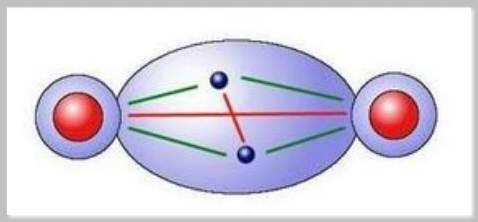
If you’re reading this article, you probably already know that a covalent bond is a pair of valence-shell electrons shared between two atoms. (That’s co- for shared, and -valent for valence.) You may be aware that they come in two forms: polar and non-polar. Both involve sharing, it’s just the manner of sharing that differs. This difference in sharing leads to different chemical and physical properties.
Imagine two children who are playing together, sharing a toy. There are two ways they can “share”; they might share equally (taking turns with the toy, perhaps) or one child will hoard the toy and leave the other child to interact only sparsely. Atoms have the same two options, but in their case the level of sharing isn’t determined by parenting, it’s based on how strongly they attract the electrons. Atoms’ relative strengths are ranked using electronegativity values.
If two atoms have similar electronegativity, they will attract and share electrons equally. On average, the electrons spend the same amount of time near each atom, so the electrons’ negative charge is distributed evenly across the bond. This results in a non-polar covalent bond, because neither end of the bond is more negative (or positive) than the other.
If one atom has a distinct advantage over the other (a difference of 0.5 or more on Pauling’s electronegativity scale – the most common one used), then the electrons are more attracted to that atom and spend more time at that end of the bond. That end of the bond winds up with a partial negative charge, thanks to the extra electron presence. The atom at the other end of the bond sees the electrons for a smaller portion of the time, and has a partial positive charge. With two oppositely charged ends, the bond is now designated polar covalent. (That’s what polar means: having two opposite ends.)
The presence of polar and non-polar covalent bonds affects how a molecule will interact with other molecules. Polar bonds can lead to stronger intermolecular forces, for instance. More important, polar bonds can encourage chemical reactions. Since the atom with lower electronegativity gets shortchanged, it can be lured away by another chemical that offers to share its electrons more fairly. (You can envision the same scenario with kids and their toys – the child who gets little playtime will stick around only until another friend comes along and says “Hey, wanna play with me?”) The overall polarity (the vector sum of all polar covalent bonds) of a molecule also affects its solubility. Polar molecules will dissolve in the polar molecule water (and in alcohol, too). Non-polar molecules will not. Similarly, non-polar molecules dissolve in non-polar solvents like benzene and octane. The presence of polar covalent bonds is largely responsible for making water such a good solvent of all things polar.
The difference between polar and non-polar covalent bonds doesn’t seem like much when you just consider the name or electronegativity numbers. When you start to look at how they change the chemistry of otherwise similar molecules, you quickly see that polarity can matter much more than the individual atoms that make up a molecule. Much of chemistry depends on which atoms are willing to share, and which are electron hogs.

